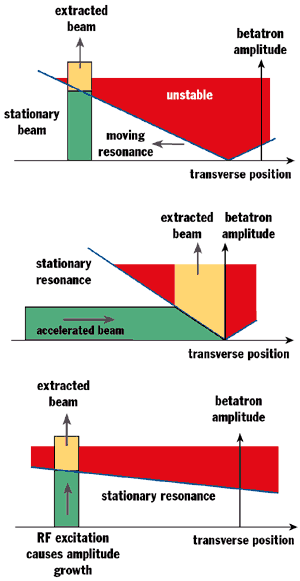CERN is host to the Proton-Ion Medical Machine Study (PIMMS),
a multinational collaboration that is looking at how particle physics can benefit medical treatment.
Increased life expectancy goes hand in hand with support from science. At present,
about one in three of us will have an encounter with cancer and,
in developed countries,
about one in eight will have this treated by a linear accelerator.
Conventional accelerator-based treatments use spread-out photon or proton beams collimated to the tumour shape. However,
some tumours are more radio-resistant while others have complex shapes and are lodged around vital organs such as the optic nerve.
For these requirements of higher radiobiological efficiency and higher precision,
the next generation of hadron therapy accelerators are arming themselves with light ions (probably carbon) and high-precision voxel (volume pixel) or raster scanning techniques that maintain millimetre precision over complex volumes.
The expertise of accelerator labs like CERN helps point the way to further progress in this fast-growing applications area of particle physics. For example,
the accelerator has to deliver the beam smoothly and controllably. Resonant slow extraction can be used from a synchrotron,
but how can the legendary sensitivity of the spill be stabilized?

Figure 1 shows how a beam can be moved into the
unstable region of a resonance for extraction.
Scenario (a) is the
classic quadrupole-driven extraction that “pushes” the
resonance across the
beam.
Scenario (b) shows the
acceleration-driven extraction (used successfully at CERN’s LEAR low-energy antiproton ring) that instead moves the
beam across the
resonance.
Finally,
scenario (c) (from Japan) blows up the
oscillation amplitudes until the
particles reach the
resonance.
The quadrupole-driven extraction (a) is analogous to turning a piece of wood on a lathe,
as illustrated in figure 2.

However,
in particle extraction the “wood” shaving is more important than the remaining wood. The wood turns about one million times to complete the extraction and the resultant wafer-thin shaving is easily destroyed by the slightest vibration.
With this classic technique,
a sharp movement between the
beam and
the
resonance for particles with a given amplitude leads to a burst of particles in the
spill with a leading peak and
a flat plateau.
The time needed for this burst to appear depends on the
initial oscillation amplitude.

The first remedial step is to adopt acceleration-driven extraction,
illustrated in figure 3 by analogy to a different kind of wood turning.
In this case,
the
shaving is composed of wood from all radii.
By mixing different initial amplitudes,
the
spikes are blurred.
Figure 4 shows the
resultant smoothing effect.

The next remedial step “front-end acceleration” is more active. Imagine a crowd on a shaking cliff being slowly pushed towards the edge by a ram (figure 5).

The victims will fall randomly,
but if ordered to take a running jump,
their increase in velocity compared to the floor movement would stabilize them and the lemming-like exodus would be more uniform.
This can be done with a slow extraction and has been demonstrated in the CERN proton synchroton. If the longitudinal phase space between resonance and beam is partially blocked by radio-frequency “buckets” (stable areas in phase space),
then the beam must dodge round them,
rather as the water in a river rushes more quickly past the piers of a bridge (figure 6).

To accelerate the
beam,
a betatron core is an ideal choice for a smooth spill and
has the
great advantage that all other parameters in the
machine can be kept constant during the
extraction.
These refinements modify the
extraction of figure 1(c) into figure 7.

CERN is hosting and supporting PIMMS (Proton-Ion Medical Machine Study),
where these and other ideas are being developed. PIMMS is a fruitful collaboration between the national organizations Med-AUSTRON in Austria,
Onkologie 2000 in the Czech Republic and the TERA Foundation in Italy. The study group has also benefited from close contacts with the GSI laboratory,
Darmstadt,
where beams of carbon ions are already being used for therapy.








